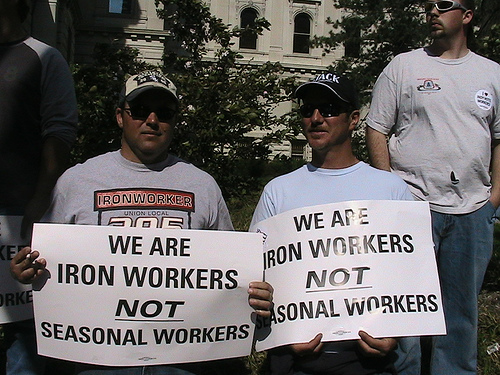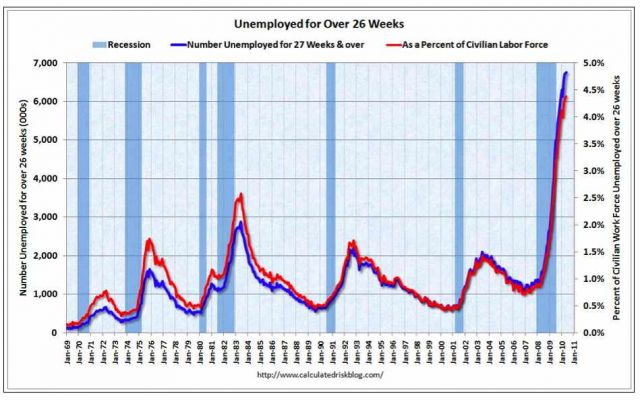
Flickr/<a href="http://www.flickr.com/photos/labor2008/3562628431/">aflcio</a>
The Labor Department put out its latest employment report today, for the month of May, and the news is decidedly mixed.
Good: The unemployment rate dropped to 9.7 percent, from 9.9 percent. (Caveat on this after the big graph below.) The US economy created 431,000 jobs last month, the most in two years and since the start of the recession in December 2007, continuing a growing trend of job creation under the Obama administration and its stimulus package. (The graph in this New York Times article illustrates this trend.) The number of part-time workers decreased last month, which lowered what many consider the real unemployment—not just the actively searching unemployed but those not searching (i.e., “discouraged workers”), the underemployed, and a few other categories—to 16.6 percent, from 17.1 percent.
Bad: 411,000 of those jobs were temporary positions for the 2010 US Census, jobs that will disappear once the summer’s over. In May, net job gain—the difference between jobs added and lost—was 390,000 for government jobs, but a meager 41,000 in the private sector. That means companies are stretching the resources and manpower they already have to meet demand instead of adding new workers to their payrolls.
Ugly: The ranks of the unemployed (but still searching) for six months or more yet again set a record, at 6.763 million Americans. That’s the highest since 1948, when the statistic was first recorded, and it accounts for almost 4.5 percent of the entire US workforce. Here’s a nifty graph showing the spike in the long-term unemployed, courtesy of the invaluable economics blog, Calculated Risk:

* As Bill McBride at Calculated Risk points out, the drop in unemployment may not be reason to cheer: “The reason the unemployment rate declined was because people left the workforce—and that is not good news.” He cites the Labor Force Participation Rate, the ratio of employed workers to the working-age population, which edged downward last month—not a good sign. “As the employment picture improves,” he writes, “people will return to the labor force, and that will put upward pressure on the unemployment rate.”
So what does today’s report mean for Obama? On the one hand, the administration can update its much-publicized, color-coded job-creation chart to show more growth in May, even though the majority of those jobs are temporary and will soon go away. Obama can also point to the 0.2 percent drop in the headline unemployment rate. But if you scratch just beneath the surface, the news isn’t all that great for the White House, and I wouldn’t expect to see the administration openly touting today’s report. “As always, it is important not to read too much into any one monthly report, positive or negative,” wrote White House economic guru Christina Romer today.
More updates to come as we dig into today’s report. Questions? Leave them in the comments, and I’ll try to answer (or call up someone who can and report that here).














